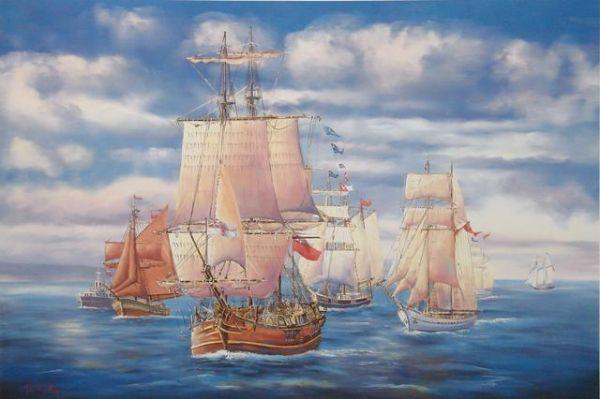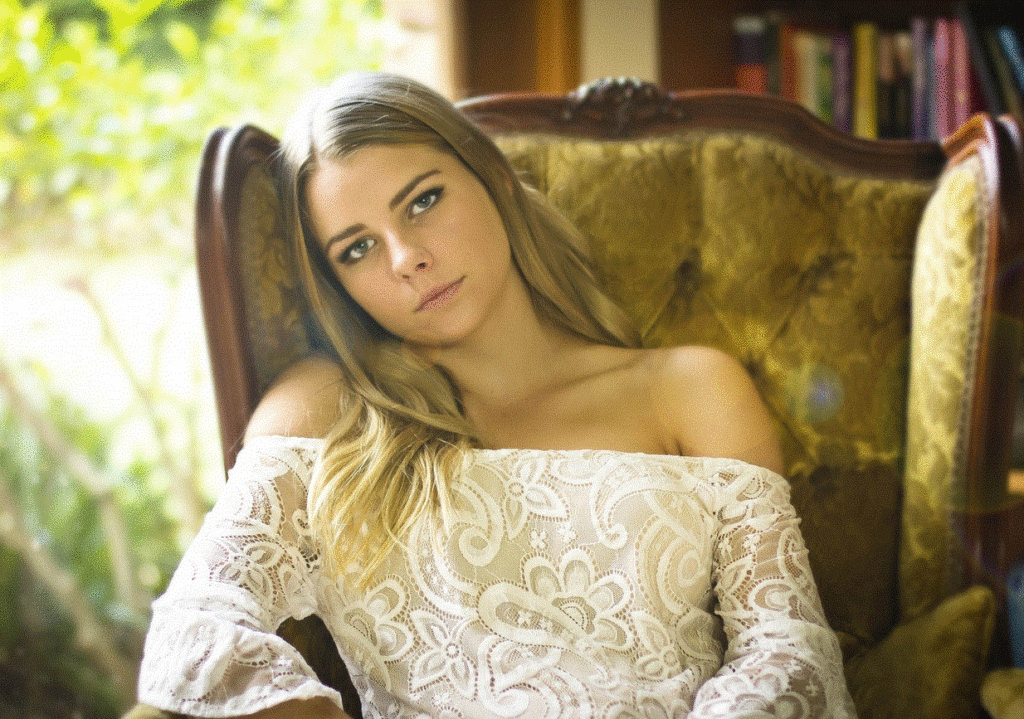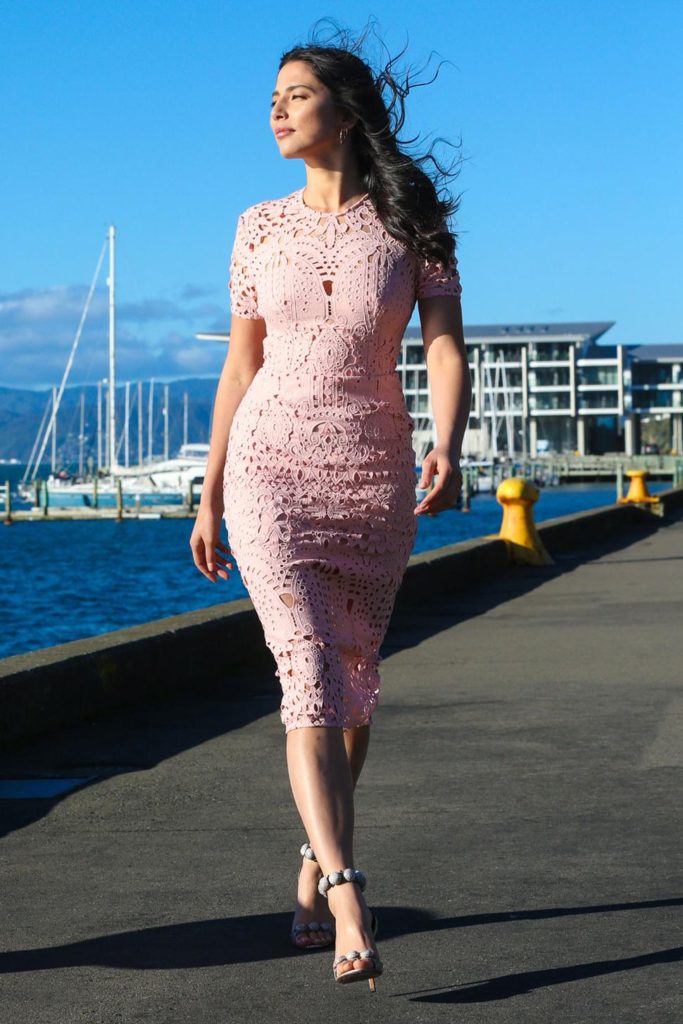This is the story of the Lady Juliana. This was a special ship designed to convey female convicts from England to Australia. The idea was that a boat load of female convicts would happily link up with a colony of convicts in Australia. Thus making everyone very, very happy, and reform the colony in New South Wales.
They were right.
And this motley crew of British women ultimately had a lasting impact on the history of Australia.
A little background information.
Great Britain began colonizing Australia in 1787 with the departure of the so-called “First Fleet” of ships. Aboard these ships were male and female prisoners, as well as officials whose goal was to establish a penal colony around modern-day Sydney. The Lady Juliana was part of the Second Fleet of ships meant to bring another round of convicts along with food and supplies for the young colony.

The British government specifically commissioned the Lady Juliana to transport a group of no fewer than 200 female convicts to Australia.
Pulled from British prisons, these convicts were torn from their families and communities to undertake a lengthy sea voyage to the other side of the world. Though conditions aboard the Lady Juliana were better than they were on most male-convict ships, it was still a long, hard journey – the ship left England in July 1789 and didn’t reach its final destination until June 1790. That’s almost an entire year.

About the convicts…
Though they were prisoners being transported against their will, many of the women of the Lady Juliana ultimately made the most of their circumstances. This was both during and after the voyage. They were quite busy with side hustles in ports of call and their romantic bartering aboard the ship. Indeed, their journey has gone down in history books as one of the most legendary.

The voyage to Australia lasted about 10 months, as the Lady Juliana voyaged from port to port in the Atlantic and Indian Oceans. The ship’s stays in places like Rio de Janeiro and Cape Town could last several weeks. The convicts made the most of their global tour by selling their services in these ports.
As John Nicol, the ship’s steward, euphemistically remembered, “We did not restrain the people on shore from coming on board through the day. The captains and seamen, who were in port at the time, paid us many visits.” The women were very busy being in high demand at the ports of call.

The ladies kept at least part of their earnings. Some of the ship’s officers and sailors allegedly even got in on the business, and their involvement raises serious questions about the degree to which these captive women were coerced into their activities.
One, a Scottish girl, broke her heart and died in the river; she was buried at Dartford. Four were pardoned on account of his Majesty's recovery. The poor young Scottish girl I have never yet got out of my mind; she was young and beautiful, even in the convict dress, but pale as death, and her eyes red with weeping. She never spoke to any of the other women or came on deck. She was constantly seen sitting in the same corner from morning to night; even the time of meals roused her not. My heart bled for her, - she was a countrywoman in misfortune. I offered her consolation, but her hopes and heart had sunk. When I spoke she heeded me not, or only answered with sighs and tears; if I spoke of Scotland she would ring her hands an sob, until I thought her heart would burst. I endeavoured to get her sad story from her lips, but she was silent as the grave to which she hastened. I lent her my bible to comfort her, but she read it not; she laid it on her lap after kissing it, and only bedewed it with her tears. At length she sunk into the grave, of no disease, but a broken heart. After her death we had only two Scottish women on board, one of them a Shetlander. -John Nicol

Many Of The Ship’s Sailors Took The Convict Women As ‘Wives’.
Whether out of love, lust, coercion, or necessity, many of the women on board the ship became the “wives” of the ship’s officers and crew members. As the ship’s steward John Nicol recalled in his memoir of the voyage: “When we were fairly out at sea, every man on board took a wife from among the convicts, they nothing loath.”
'I went every day to the town to buy fresh provisions and other necessaries for them. As their friends were allowed to come on board to see them, they brought money, and numbers had it of their own, particularly a Mrs. Barnsley, a noted sharper and shoplifter. She herself told me her family for one hundred years back, had been swindlers and highwaymen. She had a brother a highwayman, who often came to see her, as well dressed and genteel in his appearance as any gentleman. 'Those from the country came all on board in irons; and I was paid half a crown a head by the country jailors, in many cases, for striking them off upon my anvil, as they were not locked but rivetted. There was a Mrs. Davis a noted swindler, who had obtained great quantities of goods under false names and other equally base means. We had one Mary Williams transported for receiving stolen goods. She and another eight had been a long time in Newgate where Lord George Gordon had supported them. I went once a week to him and got their allowance from his own hand all the time we lay in the river. -John Nicol
While these marriages were not legal, they nonetheless served a practical purpose: taking a lover onboard the ship often meant better sleeping arrangements for the women.

But at least one partnership was rooted in genuine feeling: Nicol seemed to have fallen in love with prisoner Sarah Whitlam. Though he intended to marry her once her term ended, the two never wed. Nicol had to go back to Britain, leaving Whitlam and their child behind in Australia. He attempted to reunite with her, but they never saw each other again.
We had on board a girl pretty well behaved, who was called, by her acquaintances a daughter of Pitt. She herself never contradicted it. She bore a most striking likeness to him in every feature, and could scarce be known from him as to looks. We left her at Port Jackson. Some of our convicts I have heard even to boast of the crimes and murders committed by them and their accomplices; but the far greater number were harmless unfortunate creatures, the victims of the basest seduction. When we were fairly out at sea, every man on board took a wife from among the convicts, they nothing loath. The girl with whom I lived, for I was as bad in this point as the others, was named Sarah Whitelam. She was a native of Lincoln, a girl of modest reserved turn, as kind and true a creature as ever lived. I courted her for a week and upwards, and would have married her upon the spot, had there been a clergy man on board. She had been banished for a mantle she had borrowed from an acquaintance. Her friend prosecuted her for stealing it, and she was transported for seven years. I had fixed my fancy upon her from the moment I knocked the rivet out of her irons upon my anvil, and as firmly resolved to bring her back to England, when her time was out, my lawful wife, as ever I did intend anything in my life. She bore me a son in our voyage out. What is become of her, whether she is dead or alive, I know not. That I do not, is no fault of mine, as my narrative will show. - Excerpt from The Life and Adventures of John Nicol, Mariner printed in the Spirit of the English Magazines
Not all partnerships were as affectionate as Nicol and Whitlam’s appears to have been. The lack of privacy for prisoners on convict ships meant that crew members had access to them, and their relations and interactions could be coercive. The age of consent in 18th-century Britain was 10 years old, so some crew members took teenage wives during the voyage.

Historian Pamela Horn identified 14-year-old Jane Forbes as one such young wife – she had a baby before reaching Australia.
Colonial Officials Wanted The Women To Prevent Men From Sleeping With Each Other.
Mary Wade and Jane Whiting were transported on the Lady Juliana......This day the sessions at the Old Bailey, which began on Wednesday last, ended, when 18 convicts received sentence of death......... Of all the criminals who received lenience, those most to be regretted were two young girls, the eldest only fourteen, the youngest eleven, in whom the seeds of wickedness had taken such deep root, as to have rendered them callous to all sense of shame or feeling. These two artful hussies, Jane Whiting, and Mary Wade, seeing a child between six and seven years old in the street alone, easily decoyed it into a privy, under the Treasury wall, where they stripped and then left it to perish, with cold. Fortunately its cries attracted the notice of people nearby by, who humanely conducted the child to its friends.. (Gentleman's Magazine)
There was not an even distribution of men and women among the convict-colonists in early British Australia. Of the 759 convicts sent to Australia aboard the First Fleet, 568 were men while only 191 were women. As a result, officials worried about how all those men would find partners – some were concerned that they would turn to one another.

To correct what 18th-century Britain perceived to be “gross irregularities” in romantic partnerships in Australia, officials begged for more women. The Female Prisoners Were Expected To Civilize The Colony
The women of the Lady Juliana had a particular purpose: Colonial officials hoped that a shipload of women would help civilize the budding convict colony. According to one British official, the increased presence of women would “promote a matrimonial connection to improve morals and secure settlement.”

They were to marry male colonists, which would supposedly create and maintain respectable family life in the new colony. The women’s prison sentences aimed to transform them into moral vessels that would enable the re-creation of the British family unit abroad.
Most Of The Women Onboard The Ship Had Committed Petty Offenses
The women being transported to New South Wales on the Lady Juliana were prisoners, but their lives were upended for infractions that appear minor in the 21st century. Though some of the women aboard the Lady Juliana might have been ladies of the night, that’s not why they were sent to Australia – harlotry was not a transportable offense. Most of the women on the ship had been arrested and sentenced for various degrees of theft.
Their offenses ranged from highway robbery to shoplifting and pickpocketing. Mary Hook, for example, was around 20 years old when the British court commuted her punishment for stealing her employer’s money and goods from capital punishment to a seven-year sentence in New South Wales.

As the ship prepared to depart, a small group managed to escape. Being sent to the other side of the world may have been preferable to more severe penalties, but it was nonetheless a terrifying experience for many women; some left England with heavy hearts as they were ripped away from friends and family. They worried about their uncertain future on a new continent.
Elizabeth Barnsley Became An Enterprising Madam Aboard The Ship
One of the most notable convicts on the ship was Elizabeth Barnsley. Her offense: stealing some cloth. She quickly became a leader during the voyage. As John Nicol, steward of the Lady Juliana, recalled, “She was very kind to her fellow convicts, who were poor. They were all anxious to serve her. She was as a queen among them.”

Barnsley made the most of her circumstances and turned her position into profits – she was instrumental in overseeing her fellow convicts’ economic activities at every port along the way.
Some Of The Women Might Have Been Sex Workers In England
Though they were not being transported to New South Wales for prostitution, many of the women aboard the Lady Juliana may have been ladies of the night. A robust harlotry economy existed in 18th-century Britain, so it’s reasonable to assume that some of the 200-plus convicts took part.

Moreover, many of the passengers’ stories fell into the “fallen woman” trope that had become popular in novels and plays. John Nicol believed many of the women had been seduced at some point in their lives. He wrote about how Sarah Dorset, for example, had “fallen” into a life of alleged folly and sin:
She had not been protected by the villain that ruined her above six weeks; then she was forced by want upon the streets, and taken up as a disorderly girl; then sent onboard to be transported.
The Lady Juliana Provided Better Living Conditions Than Other Convict Ships And British Prisons.
The women aboard the Lady Juliana came from British prisons. Though a prison reform movement began to grow in the late 18th century, the prison conditions they escaped were deplorable. Prisons were overcrowded, and diseases spread swiftly.
It was still a prison ship, and most of the passenger-convicts slept just above the ship’s garbage and sewage deck. But the women of the Lady Juliana had something that their land-imprisoned counterparts didn’t: consistent access to medical care. The ship had a surgeon and was kept relatively clean.

Also, the women weren’t chained up like prisoners on other convict ships, and they could barter for improved conditions through various favors. John Nicol credited the ship’s captain with being “a humane man” who “did all in his power to make the convicts as comfortable as their circumstances would allow.”
Part of the reason the passengers on the Lady Juliana enjoyed better conditions was because the British government oversaw it, unlike the other ships in the Second Fleet. All the other vessels were operated by Camden, Calvert, and King, a notorious and prolific slave trading company. Only five women perished aboard the Lady Juliana, compared to the 267 deaths reported by the other ships.
About 1 In 5 Of The Passengers Was A Teenager
The vast majority of the women who embarked on the Lady Juliana were in their 20s and 30s. But no fewer than 51 of them – or around 22% – were teenagers. Mary Wade was one of these. Though scholars debate her exact age – recent research says she was 13, while earlier records show she was only 11 – she was the youngest convict on the ship.

Like many of her shipmates, Wade ultimately married and had a large number of children in Australia.
Drunkenness Was The Biggest Disciplinary Problem On The Ship
Though it took the Lady Juliana nearly 11 months to reach Australia, there were relatively few disciplinary problems among the convicts on the ship. One notable issue did arise involving drunkenness leading to disorderly behavior.
To curb her so-called “rowdiness,” crew members made passenger Nance Ferrel wear a repurposed wooden barrel “jacket.” When that didn’t work, they resorted to flogging her 12 times.

Many Colonists Were Annoyed When The Ship Arrived Carrying Women Instead Of Provisions
The First Fleet of convict-colonists arrived in 1788. So by the time the Lady Juliana sailed into Sydney in June 1790, the people already there were desperate to replenish their severely dwindled supplies. Many of them were disappointed to learn the Lady Juliana was a ship carrying people, not goods. One government official grumbled that the Lady Juliana carried “a cargo so unnecessary and so unprofitable as 222 females, instead of a cargo of provisions.”

Though the ship didn’t bring much in the way of food and goods, it did bring long-awaited news from home, such as dispatches that first alerted the colonists in Australia to the French Revolution that had erupted in 1789.
The Women On The Ship Had To Wear Convict Dresses
As prisoners, the women going to Australia on the Lady Juliana were expected to wear convict dresses. At least one fashionable prisoner protested this. According to the ship’s steward, Elizabeth Barnsley actually “petitioned the government agent and captain to be allowed to wear her own clothes” while the ship prepared to sail. Her request was denied, but the crew allowed her to wear whatever she wanted once the boat went to sea.

Since the convicts all wore issued dresses, the ship’s captain had the right to dispose of all the passengers’ clothing – but he didn’t, and instead held it for them. He reasoned that the garments “would be of use to the poor creatures when they arrived at Port Jackson.
Some Of The Women Brought Their Children, And Others Gave Birth On The Way
Some of the women aboard the Lady Juliana were already mothers before the ship departed England, and so they brought their children with them. Many of the convict-passengers became pregnant and even gave birth during the long voyage.

Historians generally believe five to seven babies were born on the ship, but steward John Nicol suggested no less than 20 had been born while the ship was in port at Rio. They were prepared for the births – the ship had received a small donation of baby linens before leaving England.
Life In Australia Brought New Freedoms And Opportunities For Some Of The Passengers
Unlike other convicts on prison ships, the women aboard the Lady Juliana were not chained together. They were even allowed to move freely around the boat.
And once they arrived in New South Wales, they quickly discovered they could enjoy new freedoms there that they couldn’t in England, even though they were prisoners with few rights who were put in difficult and often dangerous positions.

Women arriving in Australia were free from certain British moral codes, even while colonial officials expected them to be vessels of morality. English laws that marked children of unwed mothers as illegitimate, for example, were not enforced.
The rituals of courtship on Norfolk Island were, to put it mildly, brusque. We see the "bright intelligent" Kimberley pursuing a married convict woman named Mary Ginders with an axe, shouting that "if she did not come and live with him he would report her to the Major and have her placed in the cells." Major Foveaux got the woman of his choice, Ann Sherwin, away from one of his subordinate officers by throwing him in jail on a trumped-up charge "so that," claimed the Irish rebel leader Joseph Holt, a Norfolk prisoner at the time, "the poor fellow, seeing the danger he was in, thought it better to save his life, and lose his wife, than to lose both". At least their union lasted: Foveaux married Ann Sherwin in England in 1815.
In such a moral environment, although male convicts had some rights, however attenuated, the women had none except the right to be fed; they had to fend for themselves against both guards and male prisoners. "England for white slaves, why were they sent here," Jones scribbled in one of his outbursts of delayed guilt, while reflecting on the fate of three women sent to Norfolk Island for the "crime" of abortion, for crimes that required pity more than punishment. "Heaven forbid England if that is her way of populating her hellholes. What would our noble persons think of our virgin settlements and their white slaves. In every case the women treated as slaves, good stock to trade with and a convict having the good chance to possess one did not want much encouragement to do so."
-Convict Women
The women of the Lady Juliana were also fortunate in that they avoided the fate that awaited future generations of convict women bound for Australia – the notoriously brutal Parramatta Female Factory didn’t open until 1821, well after their sentences ended.

Though being transported to a new colony to get married and propagate British family life was no doubt daunting, many women made the most of their circumstances in Australia.
Because the women carried a very negative stigma, morals crusaders often tried to educate them regarding the folly of their ways. Women who simply stood in an "immoral pose" risked having their heads shaved and being forced to wear a collar around their neck as a mark of disgrace. The most difficult women were sent to female factories, which were essentially forced labour camps. Here they continued to be educated about the virtues of morality.
At the Cascades Female Factory in 1838, the moralising became too much for the women and they decided to make a point. The governor of Van Diemen's Land visited the factory and attended a service in the chapel. Entertaining the governor was the Reverend William Bedford, a morals campaigner whose hypocrisy had elicited the ladies' scorn. Keen to impress the governor with a fine speech, Bedford addressed the women from an elevated dais and then: "The three hundred women turned right around and at one impulse pulled up their clothes showing their naked posteriors which they simultaneously smacked with their hands making a loud and not very musical noise. This was the work of a moment, and although constables, warders etc. were there in plenty, yet 300 women could not well be all arrested and tried for such an offence and when all did the same act the ringleaders could not be picked out."
This cheeky behaviour "horrified and astounded" the governor and the male members of the party. As for the ladies in the governor's party, it was said, in a rare moment of collusion with the convict women, "could not control their laughter".
-Convict Women
In the late 18th and early 19th centuries, the Australian colonies were societies on the rise – and they created new opportunities. Some Lady Juliana passengers became upwardly mobile once their prison terms ended.

While some returned to England, others remained in Australia to make their fortune. Ann Marsh, for one, found success after being abandoned by her ship husband. She started and ran a variety of businesses, including a liquor shop and a ferry company. These women had a lasting impact on the land, becoming the so-called “founding mothers of Australia.”
On another occasion, Reverend Bedford was crossing the courtyard of the Female House of Correction, when "some dozen or twenty women seized upon him, took off his trousers and deliberately endeavoured to deprive him of his manhood. They were, however, unable to effect their purpose in consequence of the opportune arrival of a few constables who seized the fair ladies and placed them in durance vile."
The brutalization of women in the colony had gone on so long that it was virtually a social reflex by the end of the 1830s. The first full account of it was given by Robert Jones, Major Foveaux's chief jailer on Norfolk Island in the early 1800's, who thought the lot of the women prisoners there "must surely have been greater than the male convicts.... Several have not recovered yet from their treatment at the hands of the Major." Passages in Jones's memoir show how absolute the chattel status of women was. "Ted Kimberley chief constable considered the convicts of Norfolk Island no better than heathens unfit to grace the earth. Women were in his estimation born for the convenience of men. He was a bright intelligent Irishman." Jones's sentiments are echoed in a fragmentary letter from a free settler on Norfolk Island, an ex-missionary turned trader named James Mitchell. "Surely no common mortal could demand treatment so brutal," he wrote around 1815. "Heaven give their weary footsteps their aching hearts to a better place of rest for here there is none. During governorship of Major Foveaux convicts both male and female were held as slaves. Poor female convicts were treated shamefully. Governor King being mainly responsible."
-Convict Women
A new start
The hardships endured by the women appeared to build a strong sense of female solidarity. The women sang songs, which were often labelled “very disgusting”. When matrons tried to separate agitators from the group, the entire group would sometimes chant “we are all alike, we are all alike.”
Not only did the actions protect individual women, they also made convict life a bit more bearable.
The True Colonist reported in 1837 that while the “horrors of the crime class” had shocked the inhabitants of Van Diemen’s Land, what was more disagreeable to evangelical moral sensibilities was the fact that many women prefer this class to the others, because it is more lively!
There is more fun there than in the others; and we have been informed, that some of the most sprightly of the ladies divert their companions by acting plays!”
As is often the case, out of something bad came something good.
The hardships endured by the convict women seemed to build an ethic to alleviate the hardships in others. Successful convict women such as Molly Morgan never forgot their own hardships earlier in life, and donated freely to establish schools, hospitals and even churches.
Free immigrants like Caroline Chisholm also decided to do something about the suffering they saw around them. She took some women into her house and traveled the colony to find employment for others.
Within two years she had found employment and accommodation for over a thousand women and girls. She then went on to found the Family Colonization Loan Society to help break the cycle of dependence and poverty.
Chisolm’s compassion always came with strings attached.
In her hostels, she employed a tough love approach in which she made it clear that guests should never get too comfortable because they should be out looking for a job.
Mother Mary McKillop was another whose compassion probably flowed from seeing the horrors of the day. Mary took a vow of personal poverty and always shared the hardships of the people she was trying to help.
She was able to personally survive largely because people helped her as well. A society that started off as one in which everyone looked out for themselves, evolved into one in which people started looking out for others.
A society that started off as one in which everyone looked out for themselves, evolved into one in which people started looking out for others.
America, take note.
Posts Regarding Life and Contentment
Here are some other similar posts on this venue. If you enjoyed this post, you might like these posts as well. These posts tend to discuss growing up in America. Often, I like to compare my life in America with the society within communist China. As there are some really stark differences between the two.

































More Posts about Life
I have broken apart some other posts. They can best be classified about ones actions as they contribute to happiness and life. They are a little different, in subtle ways.






















Funny Pictures

Be the Rufus – Tales of Everyday Heroism.


Articles & Links
You’ll not find any big banners or popups here talking about cookies and privacy notices. There are no ads on this site (aside from the hosting ads – a necessary evil). Functionally and fundamentally, I just don’t make money off of this blog. It is NOT monetized. Finally, I don’t track you because I just don’t care to.
- You can start reading the articles by going HERE.
- You can visit the Index Page HERE to explore by article subject.
- You can also ask the author some questions. You can go HERE to find out how to go about this.
- You can find out more about the author HERE.
- If you have concerns or complaints, you can go HERE.
- If you want to make a donation, you can go HERE.


